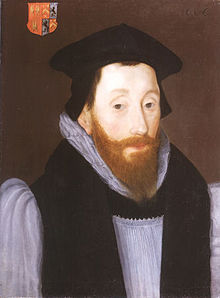George Lloyd (bishop of Chester)
George Lloyd DD | |
|---|---|
| Bishop of Chester | |
 | |
| In office | 1605-1615 |
| Predecessor | Richard Vaughan |
| Successor | Thomas Morton |
| Other post(s) | Bishop of Sodor and Man (1600-1605) |
| Personal details | |
| Born | 1560 |
| Died | 1615 (aged 54–55) |
| Denomination | Anglican |
| Spouse | Anne Wilkenson (1594-1615) |
| Alma mater | King's School, Chester Jesus College, Cambridge |

George Lloyd DD (1560– 1 August 1615)[2] was born in Wales, and became Bishop of Sodor and Man, then Bishop of Chester. He is remembered for Bishop Lloyd's House in Chester, which he had built in the years before his death, and which is recorded in the National Heritage List for England as a designated Grade I listed building.[3]
Family and education[]
Lloyd was bor in 1560 at Bryn Euryn, Llandrillo yn Rhos in Wales. His father was Meredith Lloyd of , Denbighshire, and his mother Jonet Conwy.[4][5]
He was educated at the King's School, Chester from 1575-1579. He then entered Jesus College, Cambridge.[6] There he received his B.A. in 1583, M.A. in 1586, B.D. in 1593, and finally his Doctor of Divinity in 1598.[5]
He married Anne Wilkenson in 1594 and they had six children who lived to adulthood.[2]
His daughter Anne married Thomas Yale, whose son David was father of Elihu Yale, benefactor of the college now named for him. Anne married secondly Theophilus Eaton, merchant, diplomat, and, later, one of the founders and the first governor of the New Haven Colony. The Eatons emigrated to New England in 1637, aboard the Hector of London.[7][8]
Ministry[]
Lloyd became a Fellow of Magdalene College, Cambridge around 1586. He was ordained as a curate for the church of St Peter Mancroft in Norwich by Bishop Edmund Scrambler of Norwich in January 1591.[2]
He was rector of Llanrwst, and later that same year, rector of Heswall, Cheshire from 1597.
Bishop of Sodor and Man[]
He was consecrated as Bishop of Sodor and Man in 1600.[9][10] Although this bishopric was not a lucrative one, and he even commented on the "smallness of the Bishopricke".[2] Despite this, the appointment was a significant promotion and stepping stone to a more prominent position in England. Like most of his predecessors, Lloyd rarely visited the Isle of Man and there is only one recorded visit in 1603 where he attended a Consistory Court where several offenders against the spiritual law were punished.[11] Although Lloyd did have a bishop's palace on the Isle of Man, some twenty miles north of the cathedral at Peel, he significantly refurbished a fashionable townhouse at Watergate Street in Chester.[2]
Bishop of Chester[]
In 1605 he exchanged the see of Sodor and Man for that of Chester and was consecrated in January. A former lecturer at Chester Cathedral, he was tolerant of Puritan views in his diocese.[12] During his tenure as Bishop of Chester, he reversed the anti-Puritan policies of his predecessor Richard Vaughan.[5] In local politics, he opposed Robert Whitby, a nominee of Lord Ellesmere as clerk of the Pentice, who was building a family factional position in the city.[13]
He died 1 August 1615, and was buried in Chester cathedral, where he is commemorated by a mural inscription. In the year of his death he bought Pant Iocyn, near Wrexham, formerly the residence of the Almer family, which remained the home of his family till 1634.
Notes[]
- ^ "The Armorial Bearings of the Bishops of Chester". Cheshire Heraldry Society. Retrieved 9 February 2021.
- ^ Jump up to: a b c d e McKay, Karen (2017). "HISTORY MONOGRAPH No 2 – BISHOP GEORGE LLOYD: A LIFE" (PDF). Chester Civic Trust. Retrieved 19 November 2020.
- ^ Historic England, "No.41 Street and Nos.51 & 53 Row (Bishop Lloyd's House), Chester (1376439)", National Heritage List for England, retrieved 20 July 2013
- ^ http://www.chester.gov.uk/tourism_and_leisure/culture_and_leisure/grosvenor_museum/grosvenor_museum_guide/art_gallery/george_lloyd_bishop_of_chester.aspx[permanent dead link]
- ^ Jump up to: a b c "LLOYD (or FLUDD), GEORGE (1560 - 1615), bishop of Chester". Biography Wales. Retrieved 19 November 2020.
- ^ "Lloyd, George (LLT579G)". A Cambridge Alumni Database. University of Cambridge.
- ^ Douglas Richardson, Kimball G. Everingham, Magna Carta Ancestry: A Study in Colonial and Medieval Families (2005), p. 910.
- ^ "Notes". www.dcyale.com. Retrieved 4 August 2021.
- ^ "Bishops of Sodor and Man | British History Online". www.british-history.ac.uk. Retrieved 4 August 2021.
- ^ "Bishop of Sodor and Man". www.tudorplace.com.ar. Retrieved 4 August 2021.
- ^ Moore, A.W. "Chapter 5 — The Reformation to the Restoration (1540 – 1660)". Gumbley. Retrieved 19 November 2020.
- ^ "Early modern Chester 1550-1762: Religion, 1550-1642 | British History Online". www.british-history.ac.uk. Retrieved 4 August 2021.
- ^ "Early modern Chester 1550-1762: City government, 1550-1642 | British History Online". www.british-history.ac.uk. Retrieved 4 August 2021.
External links[]
- 1561 births
- 1615 deaths
- Bishops of Sodor and Man
- Bishops of Chester
- Alumni of Jesus College, Cambridge
- Fellows of Magdalene College, Cambridge
- 16th-century Welsh Anglican priests
- 17th-century Church of England bishops
- People educated at The King's School, Chester